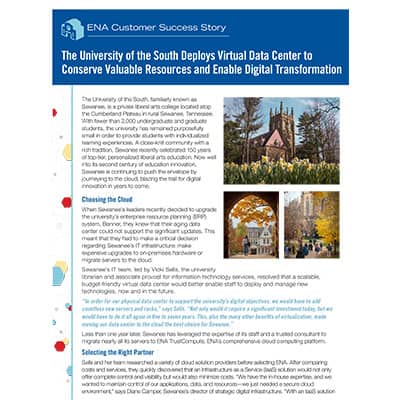Customer Success Story
The University of the South, familiarly known as Sewanee, is a private liberal arts college located atop the Cumberland Plateau in rural Sewanee, Tennessee. With fewer than 2,000 undergraduate and graduate students, the university has remained purposefully small in order to provide students with individualized learning experiences. A close-knit community with a rich tradition, Sewanee recently celebrated 150 years of top-tier, personalized liberal arts education. Now well into its second century of education innovation, Sewanee is continuing to push the envelope by journeying to the cloud, blazing the trail for digital innovation in years to come.
Choosing the Cloud
When Sewanee’s leaders recently decided to upgrade the university’s enterprise resource planning (ERP) system, Banner, they knew that their aging data center could not support the significant updates. This meant that they had to make a critical decision regarding Sewanee’s IT infrastructure: make expensive upgrades to on-premises hardware or migrate servers to the cloud.

Sewanee’s IT team, led by Vicki Sells, the university librarian and associate provost for information technology services, resolved that a scalable, budget-friendly virtual data center would better enable staff to deploy and manage new technologies, now and in the future.
“ENA TrustCompute appealed to us because of the solution’s straightforward, flat-rate billing,” says Camper. “We simply determine the amount of storage and power we need and, from there, quickly calculate the cost. It’s 100 percent predictable, making it extremely easy to present a projection to our board.”
Less than one year later, Sewanee has leveraged the expertise of its staff and a trusted consultant to migrate nearly all its servers to ENA TrustCompute, ENA’s comprehensive cloud computing platform.
Selecting the Right Partner
Sells and her team researched a variety of cloud solution providers before selecting ENA. After comparing costs and services, they quickly discovered that an Infrastructure as a Service (IaaS) solution would not only offer complete control and visibility but would also minimize costs. “We have the in-house expertise, and we wanted to maintain control of our applications, data, and resources—we just needed a secure cloud environment,” says Diane Camper, Sewanee’s director of strategic digital infrastructure. “With an IaaS solution like ENA TrustCompute, we have complete control and flexibility, and we only pay for what we need.”
In the same spirit of transparency, Sells and her team also wanted a provider who offered simple and fixed pricing.

“The reduced risk and increased disaster preparedness were big selling points for us,” says Sells. “With our servers no longer on-site, we can rest easy knowing our data is safe.”
A Trial Run
Before deploying ENA TrustCompute, Sewanee participated in a pilot to give its IT team the opportunity to test the cloud computing platform and explore the solution’s capabilities. “Our technical staff trusted that it would work, but we wanted them to be completely comfortable,” says Camper. “We knew it would help them to see it in action, so we asked ENA to put together a proof of concept. After our team witnessed ENA TrustCompute’s speed and ease-of-use, they were not only comfortable—but excited.”
Once Sells and her team determined the number of servers needed to support the latest version of Banner, as well as all associated infrastructure components, they were ready to begin their transition. However, because several of the university’s legacy systems would require updates within the year, Sewanee had to move quickly.
“Our team had the experience and expertise necessary to migrate our data center, but we didn’t have the capacity to do it in such a short timeframe,” says Camper. “In order to migrate all our servers before the end of the year, we had to divide and conquer.” With the support of ENA’s cloud engineers, Sewanee joined forces with a trusted consultant to build the university’s new, virtual data center in ENA’s secure cloud environment—and did so with months to spare.


The Benefits of Virtualization
For Sewanee, the move to the cloud has proven beneficial in more ways than one, though cost predictability has been one of the greatest advantages so far. “Because the flat-rate cost is spread out over a set number of years, our virtual data center is now an operating expense rather than a capital expense, which was appealing for budgeting purposes,” says Camper. “Our treasury office appreciates that it’s a set price and that we won’t need to purchase new hardware every few years.”
On-premises hardware requires more than just financial investment—it requires significant time investment as well. Eliminating physical equipment has enabled Sewanee’s technology staff members to focus on other priorities. “Because of the cloud, our IT team doesn’t have to spin up services or manage every single component of an on-site data center,” says Sells. “Now, they can devote more time to performing other responsibilities or exploring new opportunities for innovation.”
Another team goal was to make better use of space on campus. “We built our on-site data center 40 years ago, and today it’s prime real estate—right in the center of campus,” says Sells. “In the overall campus master plan, there is desire to utilize that space in other ways to benefit students, faculty, and staff.”
Sells also values that, in the event of a disaster on campus, Sewanee’s data center is not vulnerable to damage.
“If we have a problem, we know we can call ENA and get an immediate and knowledgeable response—which, speaking from experience, is not typical of larger companies. Our cloud needs will, undoubtedly, continue to evolve, so that kind of dedicated support is absolutely critical.”
Continued Success on the Cloud
Today, most of Sewanee’s systems—including its ORACLE database, Internet Native Banner (INB), and all Banner components—are housed in the cloud. By the end of the year, Sewanee will have shut down nearly all its on-site servers.
Camper is proud of her team’s dedication to the transformative—albeit daunting—project. “This was a huge undertaking, so we started cautiously and took a leap of faith,” says Camper. “Fortunately, our IT team is comprised of talented technology experts who are ready and willing to support Sewanee’s move to the cloud every step of the way.”
While Sewanee’s IT team will continue to leverage its expertise to oversee the university’s virtual servers and applications, Sells and her team still place high importance on their strong relationship with ENA. “It’s important for us that we develop trusted relationships with all of our technology partners,” says Sells.

